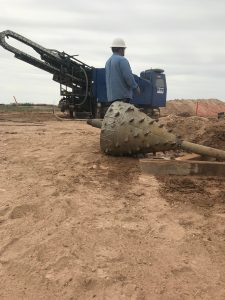24″ and 30″ Diameter Pipelines in Permian
DTD crews have recently completed several large diameter pipeline installations for a road crossing in the Permian basin. Meanwhile, similar work is ongoing. Included in the work were two pipelines (24” and 30” diameter). One boring crossed under an existing 42″ pipeline, the other underneath a major regional highway.
Petroleum exploration and production in the basin has ballooned in the last several years, but pipeline infrastructure to carry product to market has not kept pace. Midstream companies are frantically trying to catch up with demand by installing thousands of miles of pipeline. Most of the land remains undeveloped, but roads and other pipelines often present a challenge perfectly suited to HDD technology.

A 36″ Diameter Reamer At the Exit Pit Prior to Pullback
Large Diameter Pipelines Require Large Rigs
Thirty-six inch and larger diameter HDD bores require specialized equipment and are significantly more complex than the average trenchless utility installation. For one thing, the larger tooling means bigger rigs, higher mud flows and higher rotary torque. Additionally, careful borepath planning is crucial to success in the field. The bending radius of a large diameter pipeline is much less forgiving than that of smaller infrastructure.
Prior to mobilization, DTD worked with the pipeline company to optimize the borepaths of both bores. Thirty-inch diameter pipelines require bores with a large bend radius (3,000ft or more). This often means that a simple road crossing is quite long and/or requires very deep entry/exit pits. When optimizing borepaths for large diameter pipelines, the design must strike a balance. The minimum depth of the bore, the total length, and the depth of the pits all play a key role.
The 30″ road crossing pipeline required entry/exit pits that were eight feet deep, and the bore was still over 400′ in length. Industry standard requires a 2,400ft bend radius to install the 24”. By using pits that were 15ft deep, crews were able to achieve a safe separation from the 42″ existing pipeline and still limit the total length to just 200 lateral feet. Here’s a short video of 36″ reamer in action.
The field crews operated DTD’s American Augers DD10, which is a 100,000 lb pullback machine, to drill 42” and 36” diameter bores respectively. This rig is on the small size for bores of this diameter. By limiting the total length drilled and using careful drilling practice, these bores were successful. For bores of larger diameter or longer lengths, a larger rig is necessary. DTD’s 200,000 lbs-class rig would be better suited to 24″ and 30″ diameter pipeline at extended lengths.
DTD’s Reach Extends Far Beyond the Permian
With offices in Pennsylvania, Texas, and Washington, DTD continues to provide high quality environmentally safe HDD services for midstream operators on projects of all shapes and sizes, and across the country. Our 100,000 lbs rigs are well suited to a range of installations from longer, small diameter bores and shorter length, large diameter installations. Our larger range rigs are capable of handling large diameter pipeline in longer lengths.
Tags: directional drilling, HDD, large diameter, midstream, oil and gas, permian basin, pipeline, road crossing